by Jill & Sarah | Mar 18, 2020 | 2nd/3rd Grade News
This week we have been busy getting materials ready for your child. We’ve also spent some time this week training for virtual learning and setting up different learning accounts.
Please do NOT let your student work ahead on these materials. There is plenty of enrichment available online (with links in Google classroom). We want to make sure we are together in these materials and using them correctly rather than just rushing to complete them. Many of them have extension pieces that we will provide.
During this period of time the weekly newsletters will have a brief outline of the week to come. Your child will access most of our connections via their Google Classroom.
We have asked you to pick up their materials. What did we send home?
La Lectura
-
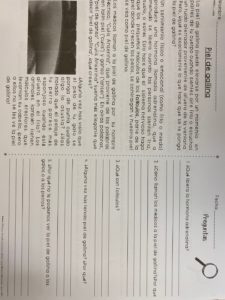
-
Reading with comprehension questions.
-
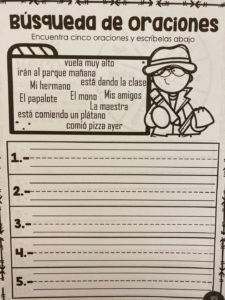
-
Grammar!
-
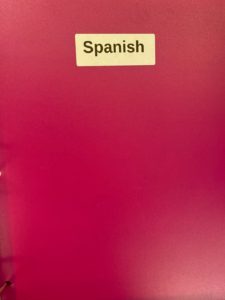
-
Spanish journal
-
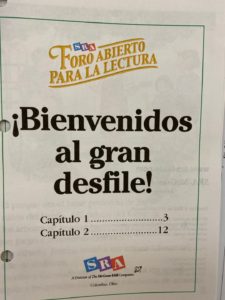
-
Spanish Readers
Las matemáticas
-
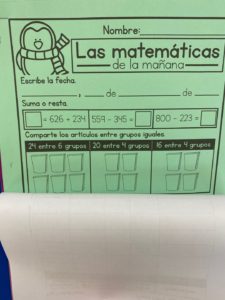
-
Daily review
-
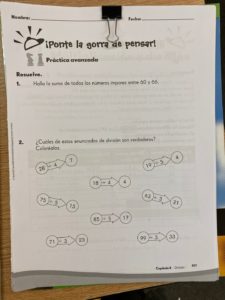
-
Finishing up chapter 8: Division and Chapter 9.
-
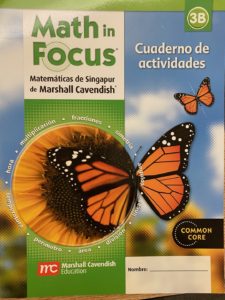
-
Starting workbook B (Don’t worry, I have links to the English version and videos with the instructions all set for Google classroom!)
-
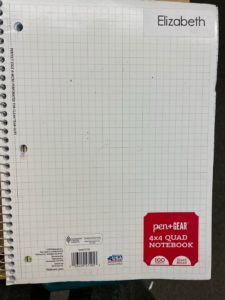
-
Math journal (They should show all their work!)
Science
Jill has some online things she will be posting through Google classroom and communicating through Zoom. We are sending home some seeds though. Please wait for instructions!
History & Geography
-
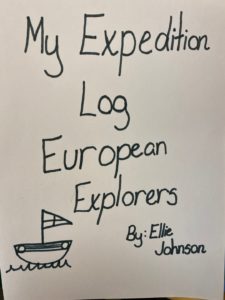
-
They will complete their European Explorers log at home.
-
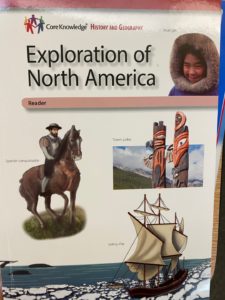
-
Be gentle with our class books. These will need to be returned!
-
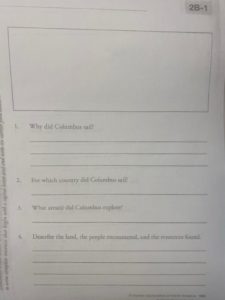
-
Ms. Jill will give more instructions on these pages for the European Explorers Log.
-
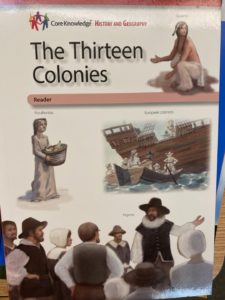
-
Be gentle with our class books. These will need to be returned!
Spelling
-
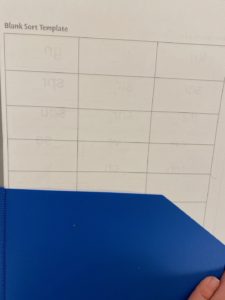
-
Ms. Jill will give you new words via Google Classroom. You will be writing them on these blank sort pages.
-
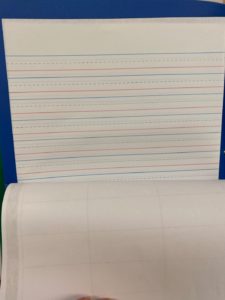
-
Hmmm. We’ll let you know what these handwriting pages are for!
-
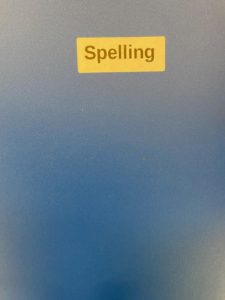
-
These pages are all found in the spelling folder of your big binder. Stay organized!
Music with Ms. Nadia
Hello 2nd and 3rd graders!
Hope y’all are enjoying the sun and making the most of our situation! To continue learning together, each week I will be sending you a music challenge in Google Classroom. There will be prizes!
The first one is already up and ready for you!
Art with Ms. Kelly
ART AT HOME Ideas
Hello Parents and Students! Here are some Art ideas for your very creative students to try at home! Each week I’ll send a Sketchbook Prompt and an Art Project suggestion. There are so many art-related resources online, but here are a few to start with:
WEBSITES:
www.Artprojectsforkids.org (many free “how to draw” ideas)
www.Cassiestephens.blogspot.com (lots of creative, fun lessons)
www.Deepspacesparkle.com (some free lessons and an “Emergency Sparkle Kit”)
Most Art Museums have wonderful websites for children!
SKETCHBOOK PROMPT:
You can make a simple sketchbook from copy paper or use a folder to collect various types of paper you already have. Write your name and date on each page!
First Day of Spring: Find a sign of spring in your yard or on a walk, such as a flower, a weed (dandelions!), a leaf, a branch with leaves or flowers, etc.
Observe it closely: What lines, shapes, colors and textures do you see? Look at the object from different angles. Make a pencil drawing of this object. Fill the page by making several drawings of the object. Challenge: Try drawing the object without lifting your pencil from the paper!
ART PROJECT:
Choose one drawing from your sketchbook and enlarge it to fill an entire page. (If possible, ask your parent if you can use their phone camera to zoom in on the object). Using a pencil, draw the outline of your leaf or flower or branch so that it touches all 4 sides of the paper. Trace over your pencil drawing with a black crayon. Then add color with crayons, markers, and/or watercolors if you have them. Observe again the colors in your object: how many different greens or yellows or browns do you see? Can you make different colors by layering crayons, or layering marker over crayon? Can you add texture by combining crayon and marker?
Look at the artwork of Georgia O’Keefe for inspiration!
by Jill & Sarah | Mar 13, 2020 | 2nd/3rd Grade News
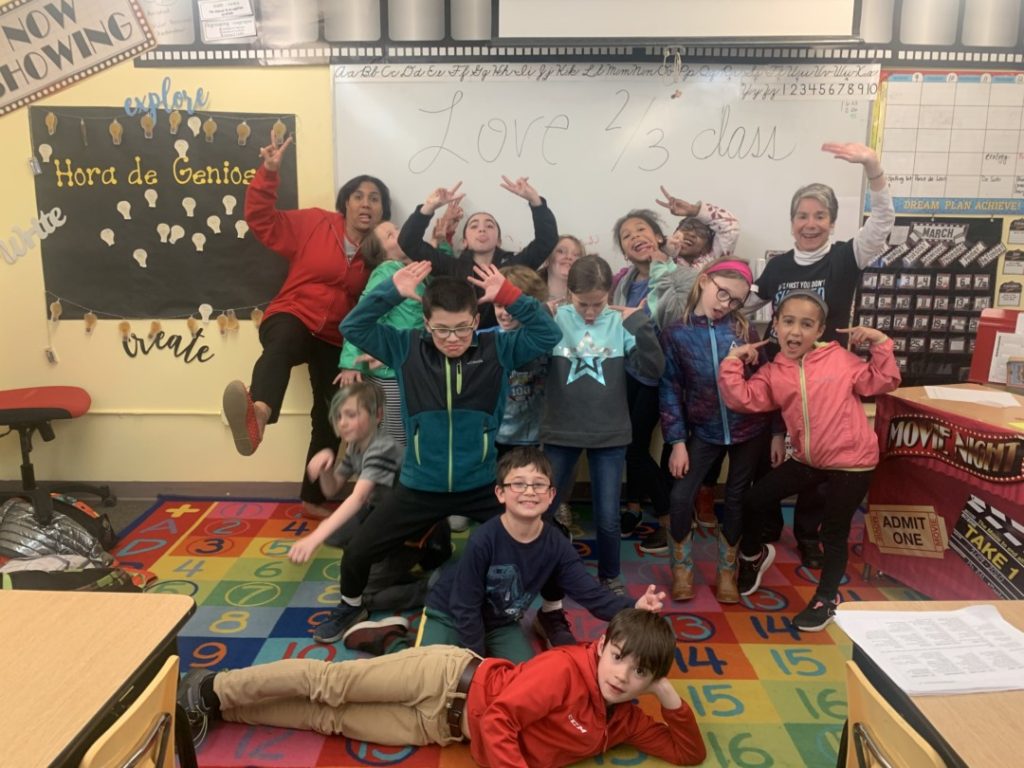
La Lectura
This week the students read: Las Pecas independently and then as a whole group.
Our objectives:
- reader review
- understand meanings of new vocabulary words
- understand fact verses fiction.
- identify articles and use them correctly in written sentences
- Use comprehension strategies such as summarizing, and predicting to construct meaning from the text during our first read
Las matemáticas
Students worked on their long division skills and had the opportunity to practice their division skills throughout the week with their “Pretzel Math” game from last week. They REALLY need to be strong on all their multiplication facts for division!
Science
this week our objectives were to:
*Describe ecology is the study of relationships between living things and their environment
*Describe and provide an example of a habitat
*Explain why certain organisms live in certain habitats and how they adapt to those habitats
*Describe and provide an example of an ecosystem
*Describe what happens in a food chain
*Identify the three essential parts of a food chain: producers, consumers, and decomposers
*Sequence of food chain of two or more trophic levels
History and Geography
This week our primary focus objectives were to:
*Describe North America is geography, including the location of the west Indies, Puerto Rico, Cuba, Caribbean Sea, and the Gulf of Mexico.
*Explain Columbus is explorations.
*Describe Ponce de Leon’s early exploration of Florida.
*Understand the meaning of the vocabulary: space, colony, empire, expedition, and settlement.
*Describe Hernando De Soto.
Summarize the explorations of De Soto.
Here are the delicious recipes of the Native American foods Bryce brought in for his presentation: venison stew and bannock bread
The 2nd/3rd grade class asked that I share the traditional recipe I found for Algonquin stew. The Algonquin Stew was used for Moose, elk, deer, and rabbit meat cuts.
Ingredients:
• Moose, venison, elk stew cuts. (you can buy stew cuts of elk and venison at New Seasons)
· 1 Onions
· 3 Carrots
· 1 Turnips
· 3 red Potatoes
· 1/2 bag of frozen sweet Corn or 1 can of sweet corn
• Flour (Gravy Mix) (corn starch is a good substitute too)
• Salt & Pepper (I used alder smoked sea salt. Check Amazon)
Directions:
Cut up in smallish quarters; potatoes, turnips, carrots and onions)
Put the meat and onions in a stew pot and let boil for 15 minutes (If using a Crock Pot, sauté onions and meat with a little smoked olive oil. I think any oil would do then I added to Crock Pot)
Add carrots, turnips, potatoes to Crock Pot, salt and pepper to taste. Add water to almost cover the ingredients in the pot and set Crock Pot to the High setting for 4 hours **or add carrots and turnips and let boil for 15 minutes or more in stew pot.
If using a stew pot NOW add potatoes, salt and pepper to taste and let boil for another 30 minutes
If using Crock Pot, add corn about 45 minutes before time is up ** and if using a stew pot -Add frozen or canned sweet corn and boil for 15 minutes
Mix ¾ cup of water and 3 tablespoons of flour in a cup (or cornstarch) and add gravy mixture to stew pot and boil for 5 minutes and serve ** if using a crock pot, about 30 minutes before you are ready to serve
Bannock Bread (can buy Red Corn Authentic Native American Fry Bread Mix on Amazon too)
· 4 cups all-purpose flour
· 1/2 teaspoon salt
· 1 tablespoon baking powder
· 1 1/2 cups warm water (110 degrees F/45 degrees C)
· 4 cups shortening for frying
Directions
Combine flour, salt, and baking powder. Stir in 1 1/2 cups lukewarm water. Knead until soft but not sticky. Let stand for 30 minutes to an hour. Shape dough into balls about 3 inches in diameter. Use flour on board and hands to make it go easier. Flatten them and pull until like a pancake size.
Fry one at a time in 1 inch of hot (375-380 degrees) Canola or vegetable oil, turning to brown on both sides. Drain on paper towels.
Bonne Appetit! Enjoy!
Character Education with Dr. Torres
Feelings Identification and Modification:
Kids can have a tough time knowing how to deal with different feelings in appropriate ways. Understanding and appreciating others’ feelings can be difficult, too. This week’s activities focused on helping students identify and deal appropriately with their feelings and their classmates’ feelings. They participated in a game called, “Guess the Feeling,” in which one student picked a card with a feeling listed on it. They then tried to get the class to guess the feeling by expressing it. This activity helped students both recognize different feelings in oneself and others, and provided an opportunity to discuss moments of misperceptions or mis-cueing of feelings (I.e., trying to express sadness, but others’ interpreting it as anger). We also talked about what makes us feel good and created a “Feel Good Journal” as a coping tool.
This class also worked on identifying and discussing how they’d feel if they were involved in a variety of scenarios provided by the teacher. This included:
-Demonstrating the ability to listen to and appreciate classmates’ opinions and feelings
-Practicing reflecting skills to ensure they truly heard and understood the other’s feeling statements.
Objectives:
Through this lesson, students will:
• Comprehend concepts related
to health promotion and disease prevention to enhance health.
• Demonstrate the ability to use interpersonal communication skills to enhance health and avoid or reduce health risks.
• Demonstrate the ability to use decision-making skills to enhance health.
• Demonstrate the ability to advocate for personal, family, and community health.
by Jill & Sarah | Mar 6, 2020 | 2nd/3rd Grade News
La Lectura
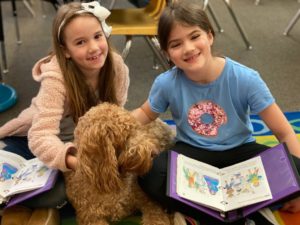
Partner reading …with a special guest.
This week we read a story from the Imaginación theme: Roxaboxen. This realistic fiction piece tells about Roxaboxen, a magical place created by children who spent many hours devising all the rules and regulations of Roxaboxen. Everyone has plenty of money, transportation, and all the ice cream they can eat. Roxaboxen is such a special place that none of the children will every forget it – no matter where they move or how old they become.
Keys points of realistic fiction include:
- The characters behave as people do in real life.
- The setting of the story is a real place or could be a real place.
- The events in the story could happen in real life.
Grammar: This week we learned about the strength of words and the tone we use in our writing. We also talked about articles which accompany nouns. Articles indicate gender and number: el, la, los, las, lo, un, unos, una, unas.
Las matemáticas
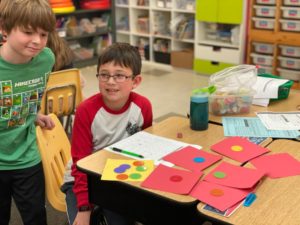 We dove right in with our unit on Division this week. Students learned that the answer to division problems is the quotient / cociente. Sometimes we are not able to divide things equally and there are some leftovers. The leftovers are called the remainder/ residuo. We talked quite a bit how we use our multiplication fact knowledge to help us with division. Students should continue practicing ALL their math facts with either flashcards or www.mathfactspro.com so they stay strong on ALL their facts and not just their current timed test facts.
We dove right in with our unit on Division this week. Students learned that the answer to division problems is the quotient / cociente. Sometimes we are not able to divide things equally and there are some leftovers. The leftovers are called the remainder/ residuo. We talked quite a bit how we use our multiplication fact knowledge to help us with division. Students should continue practicing ALL their math facts with either flashcards or www.mathfactspro.com so they stay strong on ALL their facts and not just their current timed test facts.
We introduced a division game on Friday where students play in pairs. They have 6 colored squares to share. They each have a yellow square for their remainders. Pairs started with 20 chips, rolled a dice to determine how many colored squares they would divide by. For example: They rolled 3 so they are going to divide the 20 chips into 3 equal groups. Uh-oh. There are 6 in each group but 2 left over. The two left over chips go into the remainder/residuo pile. The next player now starts with the 18 chips, rolls the die to determine how many groups to divide by, and so on. They play until there are no more chips left. The winner is the student with the most chips in their remainder/residuo. They keep track on a chart: 20 chips, 3 groups, remainder 2 : 20 ÷ 3 = 6 r2
Science
Stay tuned! We will be starting a unit on ecology shortly!
History & Geography

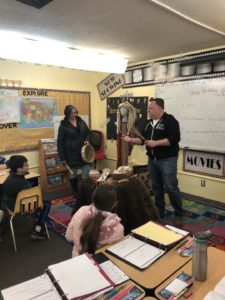
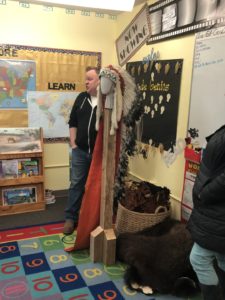
by Jill & Sarah | Feb 28, 2020 | 2nd/3rd Grade News
La Lectura
We worked on conjugating verbs into the Vosotros and the Ustedes form. The vosotros is the 2nd person plural form of verbs but is very unfamiliar in our classrooms, as we all use the ustedes form instead of vosotros. The vosotros form is only used in Spain and Equatorial Guinea, in an informal way, and Ustedes in a formal way. In Latin America, people do not generally use the Vosotros form of the verb. We are teaching it so the students are aware of it’s existence. We do occasionally hear it in songs or books. The Ustedes form is the 3rd person plural and is also mostly used i
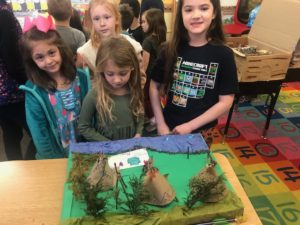
Sharing H&G projects with other classes.
n place of the 2nd person plural.
Students received their new spelling lists on Tuesday. They will have their next Spanish spelling test on Friday, March 6th.
We also worked on categorizing groups of words after finding similarities and differences. We did this using vocabulary from last week’s story: The Emperor who wore no clothes.
Las matemáticas
The kiddos did a great job with multiplication and division word problems this week. We really tried to visualize the story problems to help us truly understand which function we needed to use. I saw lots of light bulbs going on this week! Aha! Students took their end of unit test on Thursday and did a fantastic job!
Next week we will jumped right into our new Division chapter. What does this mean for our 2nd/3rd graders?
Big Idea: There can be remainders when dividing to make equal groups or when sharing equally.
- Use related multiplication facts to divide.
- Use patterns to divide multiples of 10 and 100.
- Divide a 1-digit number or a 2-digit number by a 1-digit number with or without remainder.
- Use different strategies to identify odd and even numbers.
- Use base-ten blocks and place value to divide 2-digit numbers without regrouping or remainders.
- Use base-ten blocks and place value to divide 2-digit numbers by a 1-digit number with regrouping, with or without remainders
- Thinking Skill:
- Identifying patterns and relationships
- Problem Solving Strategey:
- Key Visuals/Activities:
- Students use related multiplication facts to divide. They apply the inverse relationship of multiplication and division to write division statements from the corresponding multiplication sentence.
- Students learn that in division there is always a quotient and possibly a remainder.
- Students learn the steps of vertical division to divide with or without regrouping or a remainder.
Chapter Vocabulary:
- quotient- the answer in a division problem,
- remainder-the number leftover when a number cannot be evenly divided,
- even numbers- when an even number is divided by 2 there will not be a remainder,
- odd numbers-when an odd number is divided by there will be a remainder of 1.
History & Geography
I could not be more proud of the hard work these kids put into their reports, projects and presentations. Everyone did a fabulous job and we all learned new information about the selected tribes! Way to go kiddos!
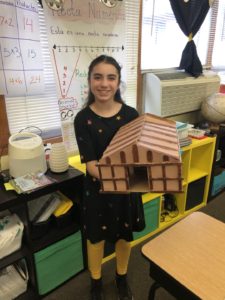
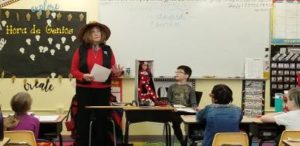
Art with Ms. Kelly
Folk Art Flower Paintings:
Goals: Learn about self-taught African American artists Clementine Hunter and Horace Pippin
“Draw” with black paint – no pencil!
Use simple shapes similar to folk artists
Try different art media: tempera paint, watercolors, and chalk pastel
These beautiful, vivid flower paintings and drawings have been on the bulletin board at school. The students were so prolific that they had enough flower art to make beautiful Valentine cards!
Weaving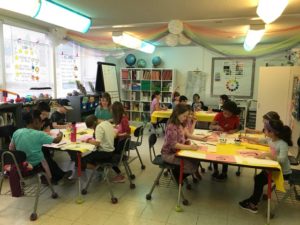
Learn weaving vocabulary: loom, warp threads, weft threads
Read A Goat in the Rug about a Navajo weaver
Create a small woven wall hanging
The students are doing a wonderful job on their weavings, and we plan to finish them next week.
Music with Ms. Nadia
Goodbye to February and Happy March! What better way to celebrate than on a bicycle built for two?
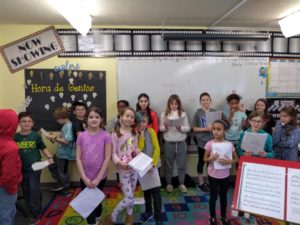 This past month has been an introduction to the choir! Not only are we learning the song A Bicycle Built for Two, the class is learning how to stand in choir formation, how to read sheet music, and fun ways to warm up our voices! Vocal warmups include One Bright and Sunny Morning, Bum-Biddily, 121, and sirens.
This past month has been an introduction to the choir! Not only are we learning the song A Bicycle Built for Two, the class is learning how to stand in choir formation, how to read sheet music, and fun ways to warm up our voices! Vocal warmups include One Bright and Sunny Morning, Bum-Biddily, 121, and sirens.
Students are also learning how to draw a treble clef and the names on of the notes on the staff. We turned the C Scale (C, D, E, F, G, A, B, c) into a secret code. The class took turns making words by writing notes on the staff, while everyone else had to guess the word. The process was then reversed, and students had to look at a word and figure out how to write the notes. Favorite words include “EGG”, “DAB”, and “GABE”. It’s a fun game to try at home!
Other highlights include weekly hangman, an Aaron Copland vs Tchaikovsky listening game, and Toystore.
by Jill & Sarah | Feb 22, 2020 | 2nd/3rd Grade News
-
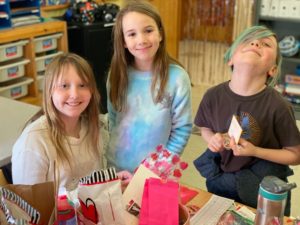
-
Happy Valentine’s Day!
-
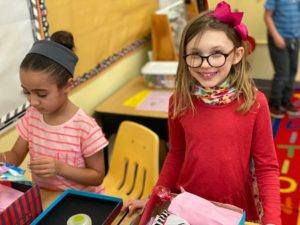
-
Valentine exchange
-
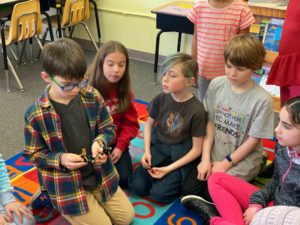
-
When all the individual pieces are put together they make something special. Great idea!
La lectura
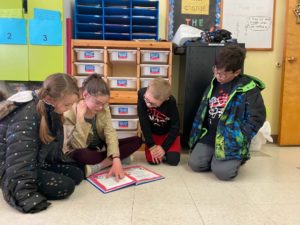
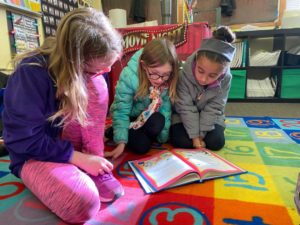
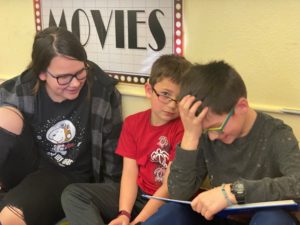 We had a great time with our story of the week: The Emperor and His New Clothes. The students did a preview, picture walk-through and then did their first reading in partners with a 4th/5th grade helper. This was so great and something we will do again soon.
We had a great time with our story of the week: The Emperor and His New Clothes. The students did a preview, picture walk-through and then did their first reading in partners with a 4th/5th grade helper. This was so great and something we will do again soon.
Students worked on their story recall by illustrating what they remembered happening at the beginning, middle and end of the story. We then re-read the story as a class, being sure to discuss more advanced vocabulary and to work on our visualizing strategy. The students then, once again, illustrated and wrote sentences describing their new understanding of the story for the beginning, middle and end. Reading stories more than once really does make a difference in our comprehension!
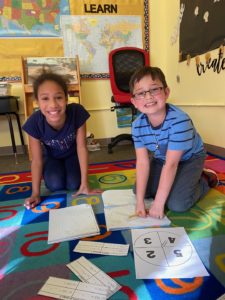 Las matemáticas
Las matemáticas
We had a great week working on our multi-digit multiplication facts. We are really working to understand the why/how of regrouping in multiplication. We worked on this using various methods throughout the week.
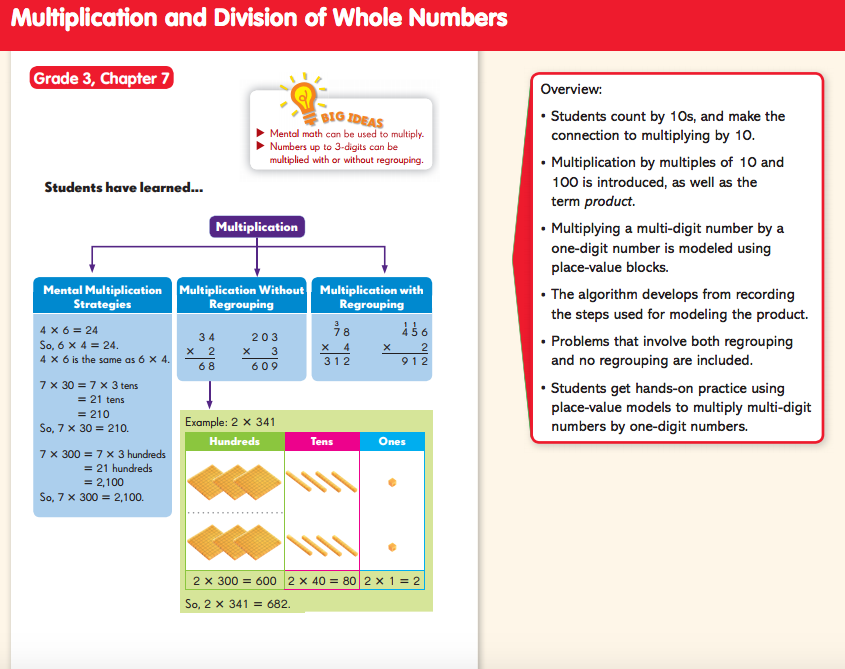
History & Geography
This week we spent much of our time wrapping up our Native American Tribe reports. Each student should have brought home their final report so they are able to practice their oral presentation at home.
We will have our presentations next week, Monday-Friday. Parents are welcome to stay for the presentations. We will do them in the first hour of our morning, so parents can stay at drop off time on the day of the their child´s presentation. Students can bring their home project to class on the day of their report, or bring it on Monday if it is finished and ready.
by Jill & Sarah | Feb 15, 2020 | 2nd/3rd Grade News
La Lectura
We continued our verb study this week with the 1st person plural: Nosotros -We. Students conjugated several AR/ER/IR verbs into the Nosotros form. They then wrote sentences in their journals and did a great job!
During our daily readings the students continued to identify the subject and predicate of sentences. They are starting to make the connection between noun -verb agreement and then use this in their own writing and speaking. I see/hear them catching themselves and doing a quick self-correct.
I did show the class how they should go back and find answers within a story. I showed them how to do this on the computer stories too.
-
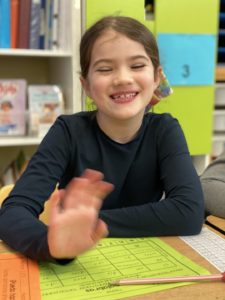
-
Making words from Centesimo Dia
-
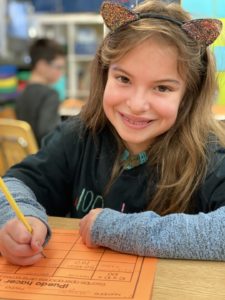
-
Ways to form 100
-
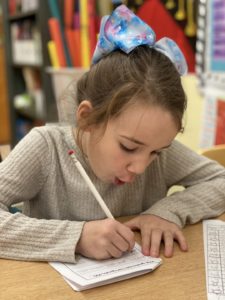
-
Writing all about 100
-
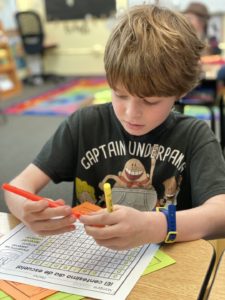
-
100 day word search
-
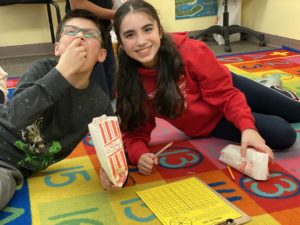
-
Multiplication race to 100 (and popcorn!)
-
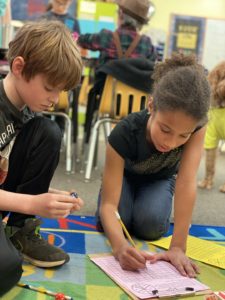
-
Multiplication: race to 1,000!
-
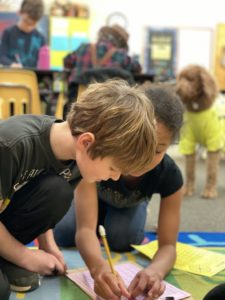
Las matemáticas
- 7.3 Multiplying with Ones, Tens, & Hundreds with Regrouping
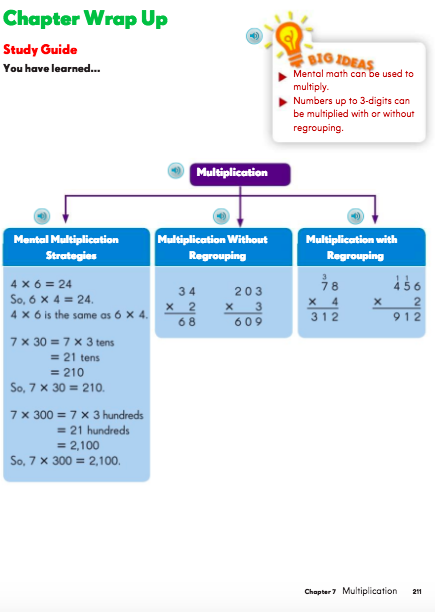
Science
What a treat we had this week with the Reptile Man´s visit! I hope your student came home with lots of stories and facts about the slithery friends they met on Tuesday.
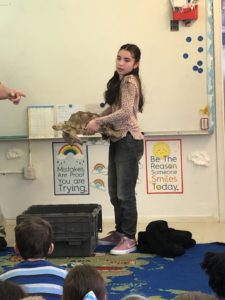
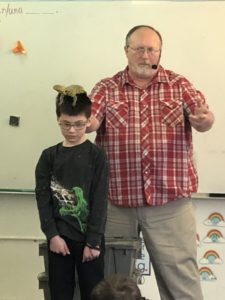
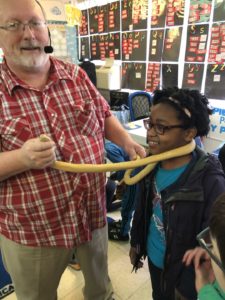
We spent this week reviewing information from our Animal Classification Unit.
History & Geography
We are continuing to work on our reports and I continue to be pleased with the students´ progress.
We also did some review of our Earliest Americans unit.
English Spelling: With back to back short weeks and a couple of fun days in the mix, we will all have our next spelling test on February 21st.
by Sarah Segall | Feb 9, 2020 | 2nd/3rd Grade News, 4th/5th Grade News, First Grade News, In The Loop, Kindergarten News, Preschool

Families like to know what the plan is for their child’s class. We have mapped out a 5-year plan to help with this.
5-Year Plan SWS
by Jill & Sarah | Feb 8, 2020 | 2nd/3rd Grade News
La lectura
The students are really starting to see how verbs work in Spanish! I am seeing the lightbulbs go off as understanding flashes! This week our objectives were:
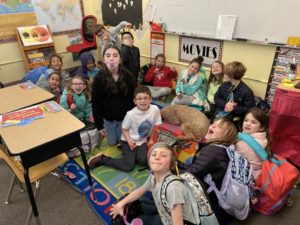
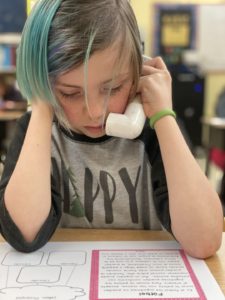 Conjugate verbs into the 3rd person singular, present tense.
Conjugate verbs into the 3rd person singular, present tense.- Write sentences in 1st, 2nd and 3rd person.
- Identify the subject and predicate of sentences.
- Read to self (whisper phones).
- Identify the main idea of a story.
- Identify supporting details in a story.
Las matemáticas
Our Unit 7 is all about multiplication. Big Idea: Mental math can be used to multiply. Numbers up to 3 digits can be multiplied with or without regrouping.
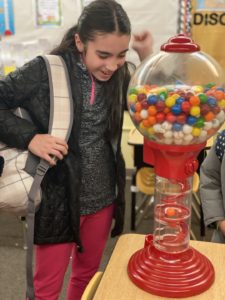 Multiply ones, tens, and hundreds mentally.
Multiply ones, tens, and hundreds mentally.- Students use skip-counting by 2 through 10 to multiply ones, tens and hundreds mentally.
- Students use base-ten blocks and place-value charts to multiply ones, tens, and hundreds with or without regrouping.
- Understand the Commutative Property of Multiplication
- Students multiply by ones, tens, and hundreds mentally
- Multiply 2- and 3-digit numbers by a 1-digit number with or without regrouping
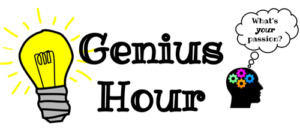
This week we continued with Step 3: Make a preliminary plan by listing steps they plan to take to complete their investigation. We also created a google document for our Genius Hour projects. This way each student can take notes at school and have access to those notes at home. Some computer skills we worked on with our projects this week:
- Creat a document.
- Name a document.
- Copy and paste.
- Copy a URL (for citing purposes) and create a link in the google doc.
- Two fingered (right-click) click to open up new menus.
Next week we will work on adding accents!
 All students successfully logged into their Google accounts and are excited about their new email! Here are the guidelines we discussed in class:
All students successfully logged into their Google accounts and are excited about their new email! Here are the guidelines we discussed in class:
- Students will not email each other during class (because face-to-face communication is always preferred)
- Students can email other students from the class but may not discuss other students.
- They should only say things in emails that they would say face-to-face and if their teachers were right there listening in.
- Kindness in our spoken and written words is always what we strive for.
- They may only email or go onto Google Docs with parent permission.
Science
This week we learned about mammals! Our learning goals were to learn about the basic characteristics of and classify particular animals as mammals. See if your student can describe these characteristics to you.
Next week we will have a special visitor, the Reptile Man, who will be introducing us to his reptile collection. I have talked with the kids that this is a very safe activity and the students will be able to participate as much or as little as they feel comfortable.
History & Geography
We continue to research and work on our reports. I am happy with the kids´ progress. At this point we are on target and do not need to assign additional work at home. The only assignment at this point for home is the project. As we get closer to the oral report days, I will ask that students read over their report (on their Google account) to ready and practiced for their presentation. We will be getting our Google accounts up and running and will be entering in our rough and then final draft.
Remember our two at-home projects? Repeat from last week’s news:
100th Day
This year the 100th day falls on Thursday, February 13th. We would like to ask the kiddos to create their very own 100th day project to bring in for this day. In keeping with the Genius Hour philosophy, the students can pick any way to share 100. Guidelines:
- Must equal 100. (That’s it!)
- Be prepared to tell the class about your project (in Spanish too!) What did you choose? Why did you choose it?
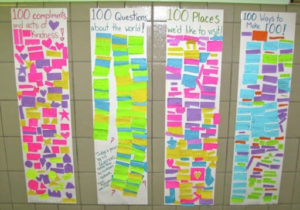
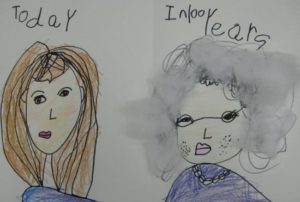 Some ideas:
Some ideas:
- 100 ways to make 100 (math!) poster.
- Poster listing 100 kind words.
- Dress up as if you are 100 years old.
- Dress up as if you lived 100 years ago.
- Poster of all things from 100 years ago.
- Snack of 100 items to share with the class (trail mix, etc.)
- Poster or bag containing 100 items.
- Endless possibilities!
Valentine’s Day
As we do not have school on February 14th, we will be celebrating Valentine’s Day on Tuesday, February 18th.
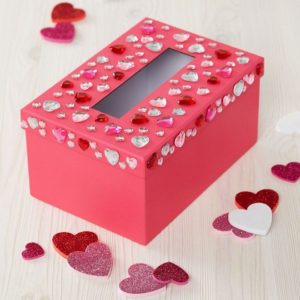 Students will exchange Valentine’s on 2/18 and should be sure to make one for each classmate.
Students will exchange Valentine’s on 2/18 and should be sure to make one for each classmate.- Students can make a box or envelope at home to bring in to collect class Valentine Cards.
- Students may bring in special treats to share in either the AM or PM.
by Jill & Sarah | Feb 1, 2020 | 2nd/3rd Grade News
La Lectura
We have really been delving into the nitty gritty of grammar. Our learning objectives this week were:
- Read and respond to comprehension questions in complete sentences.
- Identify the subject and predicate of sentences.
- Conjugate regular verbs into the present tense 1st person and 2nd person and understand how they are different.
Please make sure your child continues to read on a nightly basis. They should be reading and answering comprehension questions from the kidsa-z.com at least 2-times each week.
Las matemáticas
Students enjoyed completing some “Zombie Division” this week to help them with our weekly learning objectives:
- Students use concrete representation such as dot paper and area models to learn multiplication facts of 6, 7, 8, and 9.
- Students make use of known multiplication facts and number properties to find other unknown multiplication facts.
- Students solve problems using related multiplication facts to find the number of items in each group.
- Students solve problems using related multiplication facts to make equal groups.
- Students learn to apply the inverse relationship of multiplication and division to write division statements from a corresponding multiplication sentence.
- Write division sentences for real-world problems.
- Express division sentences for real-world problems.
We took our Unit 6 math test on Thursday. Some students are still struggling with their math facts. Please continue to have them working on their math facts at home! Check their progress on www.mathfactspro.com They should be filling in their multiplication charts with green (some have moved on to division).

Students began their next Genius Hour project this week with step 1: make a list of possible investigations. Step 2: Choose one investigation to pursue, with teacher approval.
100th Day
This year the 100th day falls on Thursday, February 13th. We would like to ask the kiddos to create their very own 100th day project to bring in for this day. In keeping with the Genius Hour philosophy, the students can pick any way to share 100. Guidelines:
- Must equal 100. (That’s it!)
- Be prepared to tell the class about your project (in Spanish too!) What did you choose? Why did you choose it?

 Some ideas:
Some ideas:
- 100 ways to make 100 (math!) poster.
- Poster listing 100 kind words.
- Dress up as if you are 100 years old.
- Dress up as if you lived 100 years ago.
- Poster of all things from 100 years ago.
- Snack of 100 items to share with the class (trail mix, etc.)
- Poster or bag containing 100 items.
- Endless possibilities!
Valentine’s Day
As we do not have school on February 14th, we will be celebrating Valentine’s Day on Tuesday, February 18th.
 Students will exchange Valentine’s on 2/18 and should be sure to make one for each classmate.
Students will exchange Valentine’s on 2/18 and should be sure to make one for each classmate.- Students can make a box or envelope at home to bring in to collect class Valentine Cards.
- Students may bring in special treats to share in either the AM or PM.
Science
This week our learning goals were to:
- Identify basic characteristics of birds
- Classify particular animals as birds
- Compare and contrast two groups of vertebrates
- Classify particular animals as mammals
History & Geography
This week we spent most of our social studies time researching our assigned tribe. I am excited to see all of the home project ideas!
Specialists
Art with Ms. Kelly
Portraits
Every year I like to have the students work on a portrait project. The goals are:
- Observe shapes of faces
- Observe placement of eyes, nose, mouth
- Observe hair color and texture, and width of shoulders
- Look at reproductions of famous portraits such as Leonardo’s “Mona Lisa”, Paul Klee’s “Senecio,” and Picasso’s self portraits
- Draw a self-portrait
Many of these portraits have been on the bulletin board at school. All the students did a great job on this challenging art project!
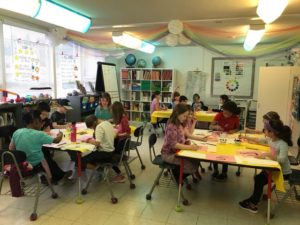 Alma Woodsey Thomas, 1891-1978, Abstract Art
Alma Woodsey Thomas, 1891-1978, Abstract Art
For Black History month coming up in February, the students learned about Alma Thomas’s perseverance as an African American woman artist of 20th century.
Some facts about Alma Thomas:
- She was an Art Teacher for 35 years
- She became a professional artist when she retired from teaching at age 69!
- First African American artist to have solo show at Whitney Museum of art in NYC
- Michele Obama chose one of Alma Thomas’s paintings to hang in the Dining Room of the White House.
The students learned how to paint in the style of Alma Thomas by using the tips of their paint brushes. They also tried “stamping” designs with erasers dipped in paint. Many of their amazing abstract pieces are on the bulletin board at school!
Still Life with Flowers
We reviewed the book Art from her Heart about folk artist Clementine Hunter, and the students began a still life picture using paint brushes – no pencils! We’ll continue this project in February.
Music with Ms. Nadia
This month we learned all about Tchaikovsky and his ballet Swan Lake. We even learned how to spell his name! (It’s true! Feel free to quiz your second or third grader!) In a game of Two Truths and a Lie, we learned that he wrote his first song at age 4, taught music after graduating from music school, and was paid to write music for 13 years by a pen-pal he never met named Nadezhda Von Meck. Strangely, his now famous ballet Swan Lake initially flopped due to poor choreography. The show has been revised several times over the past hundred years, each incorporating its own spin while paying tribute to the original. We watched a few scenes from the ballet, including a waltz from the first act and the Dance of the Swans. It’s amazing how the ballerinas all dance in sync with one another! Each act has a different feel as it tells a different part of the story, which we drew out in an active listening exercise. Each movement is full of contrasts (happy and sad, high and low, loud and quiet, day and night, etc.). We can find these contrasts in the world around us!
We have also been learning about meter, another term for time signatures. Students are now familiar with 2/4 time (two quarter notes in a measure), 3/4 time (three quarter notes in a measure), 4/4 time (four quarter notes in a measure), and the rare 5/4 time (five quarter notes in a measure). We have played rhythm games, echo games, and danced the waltz (a dance in 3/4 time). Other highlights include ballerina puppet hangman and percussion instrument challenges.

















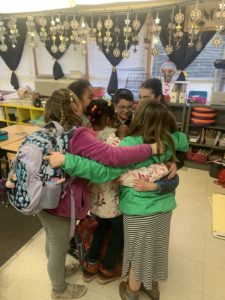

 We dove right in with our unit on Division this week. Students learned that the answer to division problems is the quotient / cociente. Sometimes we are not able to divide things equally and there are some leftovers. The leftovers are called the remainder/ residuo. We talked quite a bit how we use our multiplication fact knowledge to help us with division. Students should continue practicing ALL their math facts with either flashcards or www.mathfactspro.com so they stay strong on ALL their facts and not just their current timed test facts.
We dove right in with our unit on Division this week. Students learned that the answer to division problems is the quotient / cociente. Sometimes we are not able to divide things equally and there are some leftovers. The leftovers are called the remainder/ residuo. We talked quite a bit how we use our multiplication fact knowledge to help us with division. Students should continue practicing ALL their math facts with either flashcards or www.mathfactspro.com so they stay strong on ALL their facts and not just their current timed test facts.






 This past month has been an introduction to the choir! Not only are we learning the song A Bicycle Built for Two, the class is learning how to stand in choir formation, how to read sheet music, and fun ways to warm up our voices! Vocal warmups include One Bright and Sunny Morning, Bum-Biddily, 121, and sirens.
This past month has been an introduction to the choir! Not only are we learning the song A Bicycle Built for Two, the class is learning how to stand in choir formation, how to read sheet music, and fun ways to warm up our voices! Vocal warmups include One Bright and Sunny Morning, Bum-Biddily, 121, and sirens.




 We had a great time with our story of the week: The Emperor and His New Clothes. The students did a preview, picture walk-through and then did their first reading in partners with a 4th/5th grade helper. This was so great and something we will do again soon.
We had a great time with our story of the week: The Emperor and His New Clothes. The students did a preview, picture walk-through and then did their first reading in partners with a 4th/5th grade helper. This was so great and something we will do again soon. Las matemáticas
Las matemáticas













 Conjugate verbs into the 3rd person singular, present tense.
Conjugate verbs into the 3rd person singular, present tense. Multiply ones, tens, and hundreds mentally.
Multiply ones, tens, and hundreds mentally.
 All students successfully logged into their Google accounts and are excited about their new email! Here are the guidelines we discussed in class:
All students successfully logged into their Google accounts and are excited about their new email! Here are the guidelines we discussed in class:
 Some ideas:
Some ideas: Students will exchange Valentine’s on 2/18 and should be sure to make one for each classmate.
Students will exchange Valentine’s on 2/18 and should be sure to make one for each classmate. Alma Woodsey Thomas, 1891-1978, Abstract Art
Alma Woodsey Thomas, 1891-1978, Abstract Art